I know I have previously mentioned the Common Agriculture Policy, known in France as the Politique Agricole Commune, when I initially underwent the French agriculture policy crash course at SupAgro University. However, now that I am on the olive farm and have discussed with my hosts the role of public policy on the daily financial operation of the farm, I have a definite renewed interest. If the thought of policy makes your eyes glaze over, I will try to intersperse pretty pictures from the farm throughout my policy spiel. 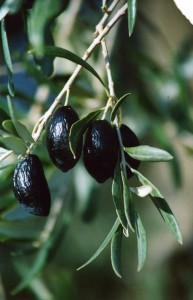
Here’s a quick description of the PAC as I understand it… Originally, the PAC was focused on the objective of increasing food production since food security was a postwar issue. Farmers were given grants and subsidies for excess food produced. By the time the 1980’s rolled around however, the opposite, food surplus, was now the problem. The policy’s aim of creating food security worked too well. The French refer to it as being a “victim de son success.” Thanks to large reforms in 2003, grants are now given to farmers independently of amount produced to avoid the problem of a food surplus.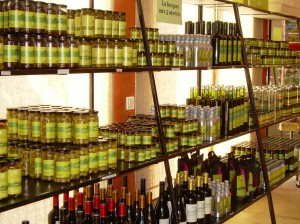
There is still income from the government through subsidies, but for example, instead of subsidizing for quantity, grants come to farmers for aspects such as sustainability and food safety practices. The farmers are free to produce whatever is most profitable for them by following market demand. I’m almost done with the simplified policy lecture here, but I do have to point out my favorite aspect of the PAC in relation to France. I find it so interesting that out of the whole EU, France gets the most money from the PAC-a whopping 42.7% even though they do not contribute the most money to the European Common Budget. Obviously, this is a source of great debate for upcoming revisions to PAC, but it just goes to show how important agriculture is here in France.
The Domaine de l’Oulivie gets such grants from the national government, the EU, and the Region, especially since the farm is working on developing themselves as an organic farm. Still, because olive growing makes up only .1% of the agricultural products produced, it is not given financial priority in relation to the PAC budget. To combat this, growers have united under AFIDOL, Association Française Interprofessionnelle de l’Olive. It is a professional olive association which includes 30,000 growers, 30 confectioners that use olives in their products, and 18 olive nurseries. In addition to having power to petition for government funding, the association assists French olive growers, such as the Domain de l’Oulivie, by providing technical knowledge specific to Mediterranean olive growing.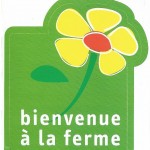
It is fantastic that there are so many organizations to assist the smaller farmer in a financially viable manner here. The farm belongs to several organizations which help market their product. One example is the French Agriculture Board’s Bienvenue a la Ferme, which is a membership program to promote regional products. For only a small fee, the farm receives publicity such as road signs. The farm also markets their products with a Qualite Sud de France label which is an association created by the Languedoc-Roussillon Region. The products are described as “coming from the soul, heart, and taste buds.” Most importantly, the label creates a brand identity that links local products to a market, and is a mark of quality for the customer. The newest organization for the Domain de l’Oulivie is the Maison de Producteurs, which is a group of producers with boutiques that sell each other’s products.
I would now like to introduce my dessert of the moment… the Canelé. It is the official pastry, with a custard center, from Bordeaux containing egg, sugar, milk, rum, and vanilla. I was doing a little research on it and found out that back in 1663 there was a registered Guild of the Canauliers, or the people that make the Canelé. Unfortunately, these people did not belong to the Pastry Guild so they were not allowed to use milk and sugar in their confections. On March 3, 1755, the council in Versailles ruled that the Canauliers were allowed to use milk and sugar. In 1767 there was another ruling passed that said a city could have only 8 Canelé shops, so the profession was highly regarded. This ruling must have not been well enforced. Also, as a point of interest, the main rum flavoring that we all so enjoy now was not added until at least the 20th century…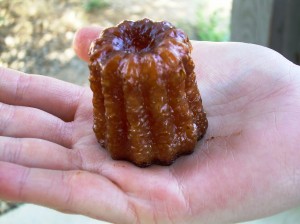

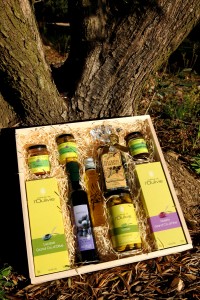
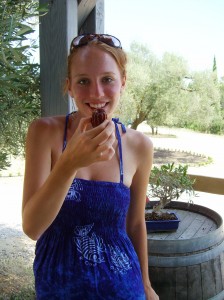
Does the Olive Farm or the AFIDOL have any marketing plans to bring their products to the USA?
Hi Chelsey,
I had as nice visit with your Dad yesterday. He told me how to access your blogs. It sounds like you’re having a fantastic summer. Will the fields adjacent to the blueberries soon become olive groves?
I knew you were special from the first time we met and your blogs only confirm that I was right.
Have a wonderful rest of the summer.
Enjoy every moment.
Bob Dunham